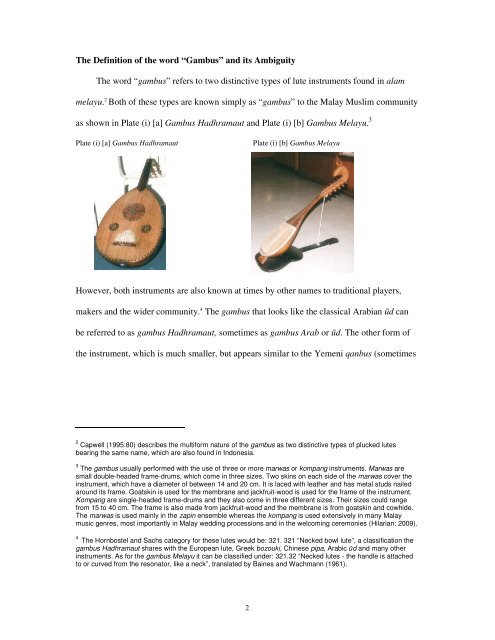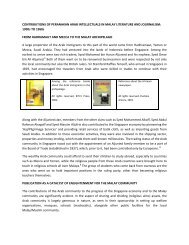The Transmission and Impact of the Hadhrami and Persian ... - Rihlah
The Transmission and Impact of the Hadhrami and Persian ... - Rihlah
The Transmission and Impact of the Hadhrami and Persian ... - Rihlah
Create successful ePaper yourself
Turn your PDF publications into a flip-book with our unique Google optimized e-Paper software.
<strong>The</strong> Definition <strong>of</strong> <strong>the</strong> word “Gambus” <strong>and</strong> its Ambiguity<br />
<strong>The</strong> word “gambus” refers to two distinctive types <strong>of</strong> lute instruments found in alam<br />
melayu. 2 Both <strong>of</strong> <strong>the</strong>se types are known simply as “gambus” to <strong>the</strong> Malay Muslim community<br />
as shown in Plate (i) [a] Gambus Hadhramaut <strong>and</strong> Plate (i) [b] Gambus Melayu. 3<br />
Plate (i) [a] Gambus Hadhramaut Plate (i) [b] Gambus Melayu<br />
However, both instruments are also known at times by o<strong>the</strong>r names to traditional players,<br />
makers <strong>and</strong> <strong>the</strong> wider community. 4 <strong>The</strong> gambus that looks like <strong>the</strong> classical Arabian ūd can<br />
be referred to as gambus Hadhramaut, sometimes as gambus Arab or ūd. <strong>The</strong> o<strong>the</strong>r form <strong>of</strong><br />
<strong>the</strong> instrument, which is much smaller, but appears similar to <strong>the</strong> Yemeni qanbus (sometimes<br />
2 Capwell (1995:80) describes <strong>the</strong> multiform nature <strong>of</strong> <strong>the</strong> gambus as two distinctive types <strong>of</strong> plucked lutes<br />
bearing <strong>the</strong> same name, which are also found in Indonesia.<br />
3 <strong>The</strong> gambus usually performed with <strong>the</strong> use <strong>of</strong> three or more marwas or kompang instruments. Marwas are<br />
small double-headed frame-drums, which come in three sizes. Two skins on each side <strong>of</strong> <strong>the</strong> marwas cover <strong>the</strong><br />
instrument, which have a diameter <strong>of</strong> between 14 <strong>and</strong> 20 cm. It is laced with lea<strong>the</strong>r <strong>and</strong> has metal studs nailed<br />
around its frame. Goatskin is used for <strong>the</strong> membrane <strong>and</strong> jackfruit-wood is used for <strong>the</strong> frame <strong>of</strong> <strong>the</strong> instrument.<br />
Kompang are single-headed frame-drums <strong>and</strong> <strong>the</strong>y also come in three different sizes. <strong>The</strong>ir sizes could range<br />
from 15 to 40 cm. <strong>The</strong> frame is also made from jackfruit-wood <strong>and</strong> <strong>the</strong> membrane is from goatskin <strong>and</strong> cowhide.<br />
<strong>The</strong> marwas is used mainly in <strong>the</strong> zapin ensemble whereas <strong>the</strong> kompang is used extensively in many Malay<br />
music genres, most importantly in Malay wedding processions <strong>and</strong> in <strong>the</strong> welcoming ceremonies (Hilarian: 2009).<br />
4 <strong>The</strong> Hornbostel <strong>and</strong> Sachs category for <strong>the</strong>se lutes would be: 321. 321 “Necked bowl lute”, a classification <strong>the</strong><br />
gambus Hadhramaut shares with <strong>the</strong> European lute, Greek bozouki, Chinese pipa, Arabic ūd <strong>and</strong> many o<strong>the</strong>r<br />
instruments. As for <strong>the</strong> gambus Melayu it can be classified under: 321.32 “Necked lutes - <strong>the</strong> h<strong>and</strong>le is attached<br />
to or curved from <strong>the</strong> resonator, like a neck”, translated by Baines <strong>and</strong> Wachmann (1961).<br />
2




